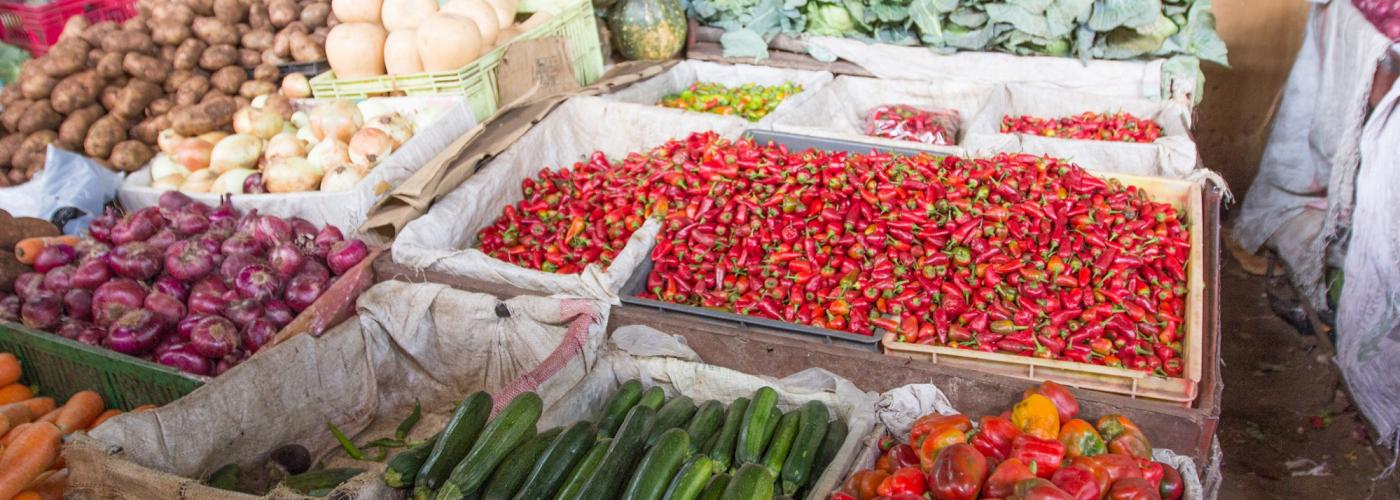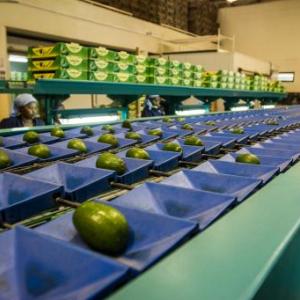COVID-19 and the New Risks for Global Food Security and Nutrition
Image

This article was originally posted on Agrilinks.org.
In this article, the Feed the Future Enabling Environment for Food Security (EEFS) project highlights the potential impacts of COVID-19 on food systems in developing countries and the need for rapid examination as the crisis unfolds to inform evidence-based decision-making.
As the COVID-19 pandemic rapidly unfolds, the global food system — particularly in the least developed countries — is at risk. Now is the time to increase awareness and knowledge of the potential implications of the pandemic on global food security and access to nutritious foods. It is imperative that we take proactive steps to ensure this health crisis does not morph into a food crisis.
In this article, we highlight a few key potential effects of this crisis that must be closely examined in developing countries to understand the depth and breadth of their impact on agricultural market system performance and food security. We anticipate that the most vulnerable segments of the global population will be the most negatively impacted by this crisis. Evidence is needed, rapidly, to help inform policy responses and potential USAID engagement moving forward.
Below we present several supply-side and demand-side risks to the food system that will require deeper consideration as the crisis unfolds.
Supply-Side Risks
Trade Barriers
Trade is a key mechanism for allocating scarce resources efficiently. Global food systems rely on trade for access to key inputs as well as to move food from surplus areas to deficit areas. As border controls are being put in place to contain the spread of the virus, cross-border trade in critical inputs like seed, fertilizer, plant protection products and on-farm equipment could be constrained. These barriers to trade increase transaction costs, in turn reducing margins for smallholder farmers and potentially decreasing their on-farm investments as well. Reduced on-farm investments could inhibit farmer’s resilience to unrelated shocks — such as droughts and pest and disease outbreaks — and generally limit their productive capacity even further.
As the world witnessed during the 2008 food price crisis, the imposition of food export bans results in reduced aggregate availability and an exacerbation of price volatility. While protectionist policies in global food trade are not yet widely evident, they may yet emerge as an ill-informed policy response to a worsening crisis. If cross-border trade in food was restricted to ostensibly protect domestic consumers from rising prices, food producers and market actors could suffer severe economic hardship and their incentives to invest in the production, processing, and distribution of food could be dampened. The risks of these policy responses in the coming months should be watched closely, and evidence of the benefits of cross-border food trade should continue to be raised.
Labor Shortages
Public health outcomes and restrictions on mobility could result in shortages of a critical factor of production for global food systems: labor. As operations within food systems in developing countries are highly labor intensive, border closures and domestic lockdowns could have the unintended consequence of limiting seasonal and casual labor availability. Additionally, increased morbidity and mortality from the virus could have a further impact on labor availability. The food systems in developing countries often rely on labor from two segments of the population that are reportedly more susceptible to severe complications from the virus — elderly people and people living with HIV/AIDS (see here and here).
Labor pressures from public health issues reduce on-farm productivity, limit processing capacity, and constrain food distribution, thereby reducing aggregate food availability and placing upward pressure on food prices. Identifying those food value chains in Feed the Future countries most susceptible to labor shortages in the coming months and seasons would be important for understanding the anticipated duration of the shock to the system and quantifying the potential effects on supply and price.
Informal Market Closures
There is a growing outcry calling for the closure of all “wet” informal markets across developing countries. Vendors in wet markets sell fresh produce and meat, often including live animals. The objective of these calls is to reduce risks for zoonotic disease spillover from animals traded in high-risk markets to human consumers as COVID-19 may have originated in a wet market. However, informal food markets serve as an important source of food and income across the developing world. Blanket closure of all informal wet markets could therefore ultimately result in shocks to food availability and income sources in some developing countries.
Regulatory efforts that enforce basic food safety standards, support best practices of live animal husbandry and species separation at markets and slaughterhouses, and prevent illegal and unsustainable wildlife trade in informal markets can help to ensure food security, public health safety, and wildlife conservation. Over the longer term, market-led initiatives will be equally important, such as supporting additional safe and sustainable domestic animal food sources, raising consumer demand for safe foods and supporting small-scale value chains for emerging supermarkets to provide safe and sustainable food sourced from local producers. All people need safe and sustainable sources of food and income. Better law enforcement, improved biosafety policies, and stronger natural resource conservation can help prevent the spread of disease.
Demand-Side Risks
Access to Nutritious Foods
The poorest segments of the population in developing countries often depend on income from casual labor along food value chains — both on farms and in firms — that may be unavailable under lockdowns. A reduction in income is likely to result in reduced access to foods. Since nutritious, fresh foods are often more expensive than nonperishable staples, it is expected that the price of nutritious foods will rise faster and become less accessible for the more vulnerable segments of society. Further, since the desire to buy goods at a higher price due to increased demand is less common in poorer countries, if prices of nutritious foods rise faster than nonperishable foods, and incomes decline, then lower overall spending on nutritious foods can be expected. Reduced access to nutritious foods could further impact immune response in populations already most vulnerable to COVID-19, including the elderly, those with underlying health conditions, and the already immune-compromised.
Global Industrial Capacity and Purchasing Power
A sharp global economic slowdown appears unavoidable as a result of lockdown measures to control the virus, and the damage to developing country agriculture sectors is expected to follow. Unlike the 2008 food crisis, a significant threat to the global food system today is crashing commodity prices due to decreased global industrial capacity and international purchasing power.
In 2008, rising global food commodity prices were closely correlated with a spike in oil prices — a key input in food production globally. Today, as global industrial capacity shuts down, oil prices are cratering, and there are signs that food commodity prices are following suit. For instance, the Cornell Alliance for Science has noted that as cashew processing factories in India, China, and Vietnam shut down, the market price of cashews has fallen 63 percent since January. Many producers in cashew producing countries such as Ghana are now struggling to break even.
In addition to slowing industrial capacity, a simultaneous decline in global aggregate demand could further exacerbate falling prices of export-oriented foods. As many developing countries are reliant on agricultural exports for foreign exchange, declines in food exports will not only impact export-oriented farms and firms, but will also influence broader macroeconomic performance that will have ripple effects through the agriculture sector.
Domestic Panic Buying
While global commodity prices are falling, there is also anecdotal evidence emerging of domestic panic buying in developing countries that is driving food prices up. For instance, according to Ghana’s Daily Graphic, panic buying in domestic food markets has caused the price of certain staple foods to jump significantly. It is unknown how widespread this behavior has been or how long it can be expected to last, but rising domestic food prices along with a collapse of global commodity prices could have a devastating impact on food security in the least developed countries.
Conclusion
We are in the midst of a global crisis, and while the number one priority of policymakers is to save lives, we must also understand the short- and long-term impacts on global food security. It remains important for governments grappling with the COVID-19 public health crisis to continue to prioritize food and nutritional security. Evidence is urgently needed to understand the severity and duration of these, and other potential impacts, on food systems in Feed the Future countries. Only then can policy and intervention responses be appropriately tailored to this unfolding crisis.
The Feed the Future Enabling Environment for Food Security (EEFS) project is a pre-competed Blanket Purchase Agreement (BPA) for USAID Missions and Operating Units to access evidence-based analysis of how legal/regulatory and institutional factors influence agricultural market system performance, food security, and nutritional outcomes. For further information on how to access EEFS expertise, please contact the Contract Officer Representative at USAID, Lourdes Martinez Romero at lmartinezromero@usaid.gov, or the Chief of Party, Adam Keatts at akeatts@fintrac.com.
References
Feed the Future Enabling Environment for Food Security, “Cross-Sectoral Policies to Transform Agriculture,” Agrilinks, March 27, 2020, https://www.agrilinks.org/post/cross-sectoral-policies-transform-agriculture.
Food and Agriculture Organization of the United Nations, “The impact of HIV/AIDS on agriculture and food security,” FAO, http://www.fao.org/3/y8331e/y8331e05.htm.
Graphic Reporters, “Coronavirus: Mad Rush for Foodstuffs Over Fear of COVID-19 Lockdown,” Ghana Daily Graphic, March 23, 2020, https://www.graphic.com.gh/news/general-news/ghana-news-mad-rush-for-foodstuffs-over-fear-of-covid-19-lockdown.html.
Joseph Opoku Gakpo, “COVID-19 Virus Spread Prompts Food Insecurity Fears in Africa,” Cornell Alliance for Science, March 26, 2020, https://allianceforscience.cornell.edu/blog/2020/03/covid-19-virus-spread-prompts-food-insecurity-fears-in-africa/.
Population Reference Bureau, “Understanding How HIV/AIDS, Agricultural Systems, and Food Security Are Linked,” PRB, April 13, 2007, https://www.prb.org/understandinglinkshivaidsagriculturefoodsecurity/.
Sif Heide-Ottosen, “The Ageing of Rural Populations: Evidence on Older Farmers in Low and Middle-Income Countries,” HelpAge International, 2014, https://www.helpage.org/silo/files/the-ageing-of-rural-populations-evidence-on-older-farmers-in-low-and-middleincome-countries.pdf.


